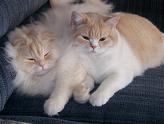|
It is often called the cutest cat known to man. Afterall, who can resist that adorable face framed with tightly
folded ears neatly capping its head, and those HUGE owl-like eyes begging for attention? Even its soft, plush, fluffy coat,
with its tufts and curls sticking out unevenly all over its muscular body, invites a generous caress. Its fear-no-evil
personality, and hug-me-til-I-burst persistence have endEARed this mutated feline to the hearts of man. This funny,
energetic, smiling creature from across the seas has been known as the "lop-eared pixie," the Scottish Shag, the fuzzy
fold, the Highland fold, and most recently as the longhair Scottish Fold.
All Scottish Folds, both longhairs and shorthairs, trace their ancestry back to the serene hills of central Scotland.
There, in 1961, a local Scot shepherd, William Ross, returning home from a day with his flock, noticed in a neighbor's barnyard
a white "pixie-faced" cat with ears bent forward, at play, seemingly unaware of her genetic uniqueness. Once home, William
mentioned this "lop-eared" cat to his wife Mary, who was already a cat fancier, and breeder of Siamese cats. The
next day, the Rosses visited the McCraes and received from them a promise of a future lop-eared kitten. Susie,
the Mc Crae's cat, presented the Rosses with a white shorthaired folded female, whom they named Snooks. It
is from Susie, through Snooks, that ALL Scottish Folds , shorthair and longhair alike, trace their parentage. No
one knows if either of Susie's parents had folded ears, or how long that this ear mutation existed in central Scotland
before being discovered. Snooks eventually chose for herself a local red tom, and produced a folded white male
kitten known as Snowball. The Rosses, proud of their self-perpetuating phenomenon, enlisted the help of the
British Cat Fancy.
Scottish Folds, as the lop-ears were eventually called, soon caught the attention and heart of the American cat
fanciers. Several were imported and bred to ANY shorthair cat available, including the Burmese, the Exotic, the British
Shorthair, the Domestic Shorthair (American SHorthair), and even a few apple-headed Siamese. The early American
breeders showed remarkable insight and wisdom in continually out-crossing their folds, thus preserving and guaranteeing
the hybrid vigor of this new breed. Sadly, as the fold gained popularity in this country, attaining championship
status by the mid-1970's, the Governing Council of the Cat Fancy, Britain's feline registry, decided to ban folds due to problems
with ear mites and deafness. (Ear mites are a catterny maintenance problem. Folds are no more prone to them than
any other breed of cat. Many of the early folds were deaf because they were blue-eyed or odd-eyed whites, and NOT because
of their folded ears!)
Of course, the British Cat Fancy might have had better grounds for banning the fold. Early breedings, experiments,
and studies with the folds revealed that when folded ears were bred to folded ears, they produced litters of two-thirds folds,
and one third straightears, of which one third of the folded ears had some form of skeletal problems. These defects
included included thickened limbs and tails, or forshortened tails, and were due to lessions on the cat's skeletal frame.
These defects were not lethal, but they did affect the movement and gait of some of the affected cats. Apparently,
the mutated gene that caused the ears to fold, could also affect the limbs and tails. This frightening discovery
prompted the early fold breeders to start breeding folds to straight-ears, either straight-ear folds, British Shorthairs
or American Shorthairs. These precautions have virtually eliminatred all defects except for an occasional
stiff tail. It has been suggested that if Scottish Fold breeders continue to outcross their cats, avoiding all fold-to-fold
breedings,the skeletal lesions defect may be eventually bred out, and that one day, fold-to-fold breedings will be considered
safe and reasonable.
|

